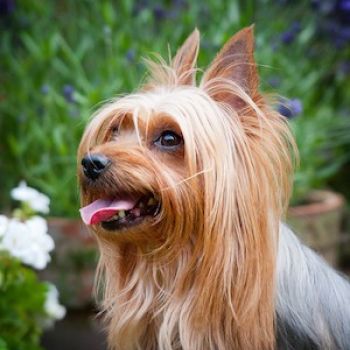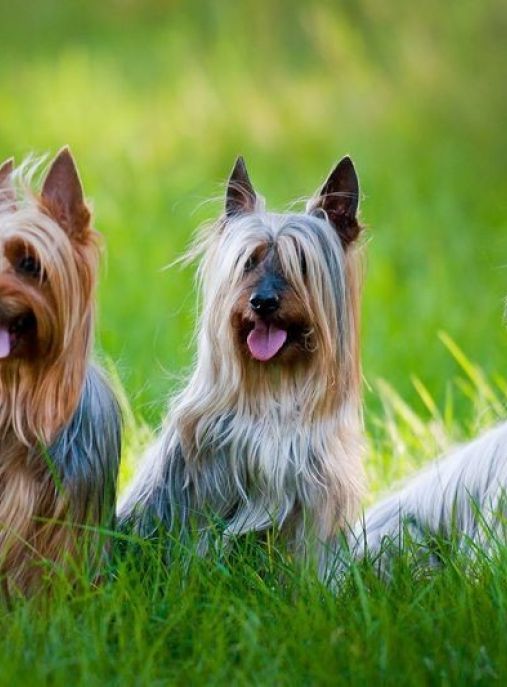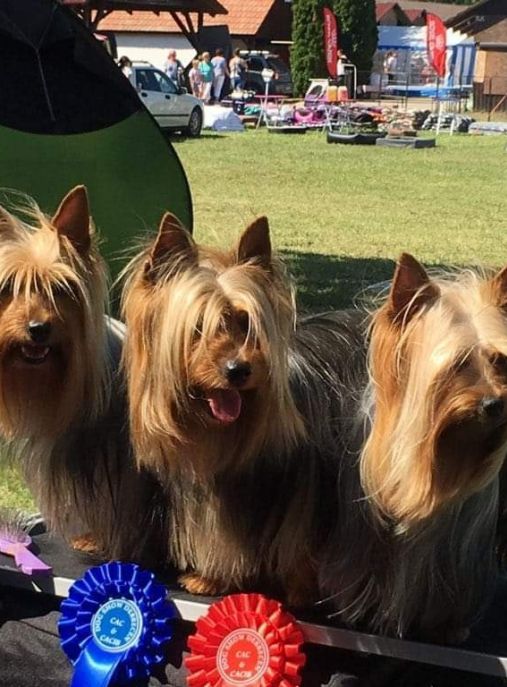The Australian Silky Terrier, also known as the Silky Terrier or simply Silky, is a small and elegant dog breed that originated in Australia. With its silky, flowing coat and confident demeanor, this breed is a beloved companion and show dog. In this text, we will delve into the history, characteristics, and interesting facts about the Australian Silky Terrier.
The history of the Australian Silky Terrier can be traced back to the late 19th century in Australia. It is believed that the breed was developed by crossing Yorkshire Terriers brought by immigrants from England with Australian Terriers. The goal was to create a small, agile, and intelligent dog that could excel in hunting small game and also serve as a companion.
According to the FCI (Fédération Cynologique Internationale) typology, the Australian Silky Terrier belongs to Group 3 - Terriers. This group includes various terrier breeds that share common characteristics such as courage, tenacity, and a strong prey drive. Within this group, the Silky Terrier is classified in Section 4 - Toy Terriers. This section comprises small-sized terriers that are primarily kept as companions.
The Australian Silky Terrier is primarily a companion dog, known for its loyalty and affection towards its family. They thrive in households where they receive ample attention, love, and mental stimulation. Despite their small size, they possess a confident and outgoing personality. They are also known for their alertness, making them excellent watchdogs. However, they may exhibit a certain level of stubbornness, so consistent and patient training is necessary.
In terms of physical characteristics, the Australian Silky Terrier is a small-sized dog. On average, males stand about 9-10 inches (23-25 cm) tall at the shoulder, while females are slightly smaller, measuring around 8-9 inches (20-23 cm). Their weight typically ranges between 8-11 pounds (3.5-5 kg). Despite their small stature, they have a well-muscled body and a sturdy build.
One of the most distinctive features of the Australian Silky Terrier is its luxurious, silky coat. The coat is long, fine, and glossy, falling straight down on either side of the body. The coloration is predominantly blue and tan, with a rich blue-gray body and tan markings on the face, ears, chest, and legs. Regular grooming is necessary to maintain the coat's beauty and prevent matting.
The Australian Silky Terrier has a moderate life expectancy, typically ranging from 12 to 15 years. However, with proper care, some individuals have been known to live even longer. Regular exercise is essential to keep them physically and mentally stimulated. Daily walks, play sessions, and interactive toys can help meet their exercise needs.
While the Australian Silky Terrier is generally a healthy breed, they may be prone to certain health issues. These can include patellar luxation (knee joint dislocation), Legg-Calve-Perthes disease (a hip joint disorder), dental problems, and allergies. Regular veterinary check-ups, a balanced diet, and proper dental care can help mitigate these risks.
In addition to their physical attributes, the Australian Silky Terrier possesses several interesting traits. They are known for their intelligence and quick learning ability, making them highly trainable. They excel in various dog sports and activities such as obedience, agility, and even tracking. Their small size and adaptability also make them suitable for apartment living, as long as they receive sufficient exercise and mental stimulation.
The Australian Silky Terrier is a breed that thrives on human companionship. They form strong bonds with their families and are known to be excellent with children when properly socialized. However, due to their terrier instincts, they may not always get along well with other small pets or animals. Early socialization and proper introductions are crucial to ensure harmonious relationships with other pets.
In conclusion, the Australian Silky Terrier is a delightful and elegant breed that brings joy and companionship to many households. With their silky coat, confident personality, and intelligence, they make excellent companions and show dogs. Their small size, adaptability, and loyalty make them well-suited for various living situations. If you are looking for a small, affectionate, and lively companion, the Australian Silky Terrier may be the perfect choice for you.

The Australian Silky Terrier, also known as the Silky Terrier or simply Silky, is a small and elegant breed that originated in Australia. These dogs are known for their beautiful silky coats, lively personalities, and loyal nature. With their unique combination of intelligence, playfulness, and affection, Silky Terriers make wonderful companions for individuals and families alike.
In terms of behavior, Silky Terriers are generally lively, alert, and curious. They possess a high level of energy and enjoy being involved in various activities. These dogs are known for their playful nature and love to engage in interactive games and exercises. Silky Terriers are also highly intelligent and quick learners, which makes them relatively easy to train.
When it comes to raising and training a Silky Terrier, it is important to establish a consistent and firm yet gentle approach. These dogs respond well to positive reinforcement techniques such as praise, treats, and rewards. Early socialization is crucial to ensure they grow up to be well-rounded and confident dogs. Exposing them to different people, animals, and environments from a young age will help prevent any potential behavioral issues.
Silky Terriers are known to be loyal and devoted to their families. They form strong bonds with their owners and thrive on human companionship. They enjoy being involved in family activities and are often eager to participate in any adventure or outing. However, they can sometimes exhibit a stubborn streak, so it is important to establish clear boundaries and consistent rules from the beginning.
Despite their small size, Silky Terriers possess a natural instinct to protect their loved ones. They are known to be excellent watchdogs and will alert their owners to any potential danger or intruders. However, this protective nature can sometimes lead to excessive barking, so early training to control this behavior is essential.
Grooming is an important aspect of caring for a Silky Terrier. Their beautiful, silky coats require regular brushing to prevent matting and tangling. Additionally, they may need occasional professional grooming to maintain their coat's health and appearance. Silky Terriers are considered a low-shedding breed, making them suitable for individuals with allergies.
Regular exercise is necessary to keep Silky Terriers physically and mentally stimulated. Daily walks, playtime, and interactive toys are essential to prevent boredom and destructive behavior. Despite their small size, they have a surprising amount of energy and enjoy activities such as agility training or obedience trials.
In conclusion, the Australian Silky Terrier is a delightful breed with a lively and affectionate character. They are intelligent, playful, and loyal, making them excellent companions for individuals and families alike. With proper training, socialization, and care, Silky Terriers can thrive in various environments and bring joy to their owners' lives.
The Australian Silky Terrier, also known as the Silky Terrier or simply Silky, is a small and elegant breed that requires specific care to ensure their well-being and happiness. Here are some tips on how to properly care for Australian Silky Terriers, including what to do and what not to do:
1. Grooming: Silky Terriers have a beautiful, long, and silky coat that requires regular grooming. Brush their coat daily to prevent matting and tangling. Regular bathing is also necessary, but be sure to use a mild dog shampoo to avoid skin irritation. Additionally, trim their nails regularly and clean their ears to prevent infections.
2. Exercise: Despite their small size, Silky Terriers are energetic dogs that require regular exercise. Take them for daily walks or engage in play sessions to keep them physically and mentally stimulated. However, be cautious not to overexert them, as they can be prone to respiratory issues.
3. Training: Silky Terriers are intelligent and eager to please, making them relatively easy to train. Start training them from a young age, using positive reinforcement techniques such as treats and praise. Be consistent and patient, as they can be stubborn at times. Socialization is also crucial to prevent them from becoming overly protective or anxious around strangers.
4. Dental Care: Like many small breeds, Silky Terriers are prone to dental problems. Establish a regular dental care routine by brushing their teeth at least two to three times a week. Additionally, provide them with dental chews or toys to help keep their teeth clean and healthy.
5. Health Care: Regular veterinary check-ups are essential to monitor the overall health of your Silky Terrier. Ensure they receive all necessary vaccinations, flea and tick prevention, and heartworm medication. Discuss with your vet about any breed-specific health concerns, such as patellar luxation or Legg-Calve-Perthes disease, and take appropriate preventive measures.
6. Nutrition: Provide your Silky Terrier with a well-balanced and high-quality diet suitable for their age, size, and activity level. Avoid overfeeding, as Silky Terriers can be prone to obesity. Consult with your vet to determine the right portion sizes and feeding schedule for your dog.
What NOT to do:
1. Do not leave your Silky Terrier alone for extended periods. They thrive on companionship and can develop separation anxiety if left alone for too long.
2. Do not neglect their grooming needs. Regular brushing and bathing are essential to maintain their coat's health and prevent discomfort.
3. Do not skip training or socialization. Silky Terriers can become yappy or aggressive if not properly trained and socialized from an early age.
4. Do not ignore their dental care. Poor dental hygiene can lead to serious health issues, so make sure to establish a regular dental care routine.
5. Do not overfeed or give excessive treats. Silky Terriers are prone to weight gain, which can lead to various health problems. Stick to a balanced diet and monitor their weight regularly.
Remember, each Silky Terrier is unique, and their care may vary slightly. It's crucial to provide them with love, attention, and a safe environment to thrive and be a cherished member of your family.
The Australian Silky Terrier, also known as the Silky Terrier, is a small and elegant breed that is known for its luxurious and silky coat. When it comes to their color, these dogs typically have a stunning and unique combination of shades that adds to their overall charm and appeal.
The most common color seen in Australian Silky Terriers is a beautiful shade of blue and tan. The blue color is often described as a steel blue or silver-blue, which gives these dogs a distinctive and eye-catching appearance. This hue is usually seen on the body, back, and sides of the Silky Terrier.
The tan color, on the other hand, is usually found on specific areas of the dog's body, such as the face, ears, legs, and sometimes the tail. This tan shade is often described as a rich and warm caramel or honey color, which provides a lovely contrast to the blue coat.
The distribution of these colors on the Silky Terrier's body is quite specific and follows a pattern. The blue color is dominant on the upper parts of the dog, while the tan color is more prominent on the lower parts. This creates a striking visual effect, as if the dog is wearing a blue coat with tan accents.
The blue coat of the Australian Silky Terrier is usually dense and glossy, giving it a luxurious and silky texture. It is often straight and falls gracefully along the dog's body, enhancing its elegant appearance. The tan areas, on the other hand, may have a slightly different texture, appearing softer and fluffier.
In addition to the blue and tan combination, some Australian Silky Terriers may also have small patches of white on their chest or paws. These white markings add a touch of brightness to their overall color scheme and further enhance their unique and adorable look.
It is important to note that the color of Australian Silky Terriers can vary slightly from dog to dog. Some individuals may have a lighter or darker shade of blue, while others may have more or less tan on their bodies. However, the blue and tan combination remains the most common and recognized color for this breed.
Overall, the color of Australian Silky Terriers is a captivating blend of blue and tan, creating a striking and elegant appearance. Their silky and glossy coat, along with the specific distribution of these colors, adds to their charm and makes them truly stand out in the canine world.
The Australian Silky Terrier, also known as the Silky Terrier, is a small and elegant breed that originated in Australia. Known for their silky, flowing coats and lively personalities, these dogs make excellent companions. However, like all breeds, they are prone to certain health issues that owners should be aware of to ensure their well-being.
One of the most common health concerns in Australian Silky Terriers is patellar luxation. This condition occurs when the kneecap slips out of its normal position, causing discomfort and lameness. Regular exercise and maintaining a healthy weight can help prevent this condition. If your Silky Terrier shows signs of limping or difficulty walking, consult with a veterinarian for proper diagnosis and treatment options.
Another health issue that affects this breed is dental problems. Silky Terriers are prone to dental diseases such as periodontal disease and tooth decay. Regular dental care, including brushing their teeth and providing dental chews, can help prevent these issues. Additionally, scheduling regular dental cleanings with a veterinarian is crucial to maintain good oral health.
Silky Terriers are also susceptible to allergies, which can manifest as skin irritations, itching, and hair loss. Allergies can be caused by various factors, including food, environmental allergens, or even certain grooming products. Identifying and avoiding the allergens, along with regular grooming and bathing, can help manage these allergies. If the symptoms persist or worsen, consult with a veterinarian for further evaluation and treatment options.
Another common health concern in Silky Terriers is Legg-Calve-Perthes disease. This condition affects the hip joint and can cause pain, lameness, and muscle atrophy. While the exact cause is unknown, it is believed to be a genetic condition. Surgical intervention is often required to alleviate the discomfort and improve the dog's quality of life.
Additionally, Silky Terriers are prone to developing eye problems such as cataracts, progressive retinal atrophy (PRA), and glaucoma. Regular eye examinations by a veterinarian can help detect these conditions early on, allowing for appropriate treatment or management strategies.
To ensure the overall health and well-being of your Australian Silky Terrier, it is essential to provide them with proper care. Regular exercise is crucial to keep them physically fit and mentally stimulated. Daily walks, playtime, and interactive toys can help meet their exercise needs.
Maintaining a balanced diet is also vital for their health. Feed them high-quality dog food that is appropriate for their age, size, and activity level. Avoid overfeeding and monitor their weight to prevent obesity, which can contribute to various health issues.
Regular veterinary check-ups are essential to monitor their overall health and catch any potential problems early on. Vaccinations, parasite prevention, and routine blood work are all part of a comprehensive healthcare plan for your Silky Terrier.
Grooming is another crucial aspect of caring for a Silky Terrier. Their long, silky coats require regular brushing to prevent matting and tangling. Professional grooming every 6-8 weeks is recommended to maintain their coat's health and appearance.
In conclusion, while Australian Silky Terriers are generally healthy dogs, they are prone to certain health issues. Being aware of these common conditions and taking proactive steps to prevent and manage them is crucial for their well-being. With proper care, regular veterinary check-ups, and a loving environment, your Silky Terrier can lead a happy and healthy life.
The Australian Silky Terrier is a small and energetic breed known for its beautiful silky coat and lively personality. To ensure the overall health and well-being of these dogs, it is crucial to provide them with a balanced and nutritious diet. Proper nutrition plays a vital role in maintaining their energy levels, promoting healthy growth, and preventing potential health issues.
When it comes to feeding an Australian Silky Terrier, it is essential to choose high-quality dog food that meets their specific nutritional needs. Look for a well-balanced commercial dog food that is specifically formulated for small breeds. These foods are designed to provide the right balance of proteins, carbohydrates, fats, vitamins, and minerals necessary for their overall health.
Protein is a crucial component of a Silky Terrier's diet as it supports muscle development and repair. Look for dog foods that list high-quality sources of protein such as chicken, beef, fish, or lamb as the primary ingredient. Avoid foods that contain excessive amounts of fillers, by-products, or artificial additives, as these can be detrimental to their health.
Carbohydrates are an important energy source for dogs, but it is crucial to choose complex carbohydrates that are easily digestible. Look for dog foods that contain whole grains like brown rice or oats, as they provide essential nutrients and fiber. Avoid foods that contain excessive amounts of corn, wheat, or soy, as these can cause allergies or digestive issues in some dogs.
Fats are another essential component of a Silky Terrier's diet. Healthy fats, such as omega-3 and omega-6 fatty acids, are beneficial for their skin and coat health. Look for dog foods that contain sources of healthy fats like fish oil or flaxseed oil. These fats also support brain development and overall immune function.
In addition to commercial dog food, it is also beneficial to include some fresh and natural foods in their diet. Lean meats, such as boiled chicken or turkey, can be added as a protein source. Cooked vegetables like carrots, green beans, or sweet potatoes can provide additional vitamins and minerals. However, it is important to avoid feeding them toxic foods like onions, garlic, grapes, or chocolate, as these can be harmful to their health.
Proper portion control is crucial to prevent obesity, which can lead to various health issues. Follow the feeding guidelines provided on the dog food packaging, and adjust the portions based on your Silky Terrier's age, weight, activity level, and overall health. It is advisable to divide their daily food intake into two or three smaller meals to aid digestion and prevent bloating.
Always ensure that fresh and clean water is readily available for your Silky Terrier. Hydration is essential for their overall health and helps maintain proper organ function.
Regular exercise is also crucial for the overall well-being of Australian Silky Terriers. Along with a nutritious diet, provide them with daily walks, playtime, and mental stimulation to keep them physically and mentally fit.
In conclusion, providing a well-balanced and nutritious diet is essential for the health and happiness of Australian Silky Terriers. Choose high-quality commercial dog food specifically formulated for small breeds, and supplement it with fresh and natural foods. Avoid toxic foods and maintain portion control to prevent obesity. By following these guidelines, you can ensure that your Silky Terrier thrives and enjoys a long and healthy life.










